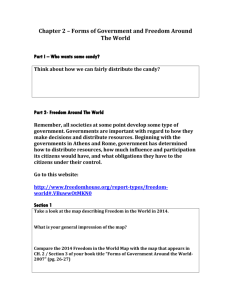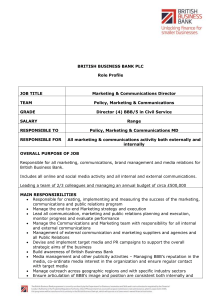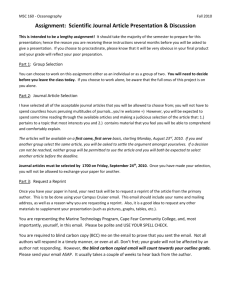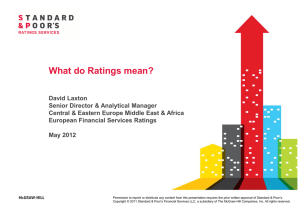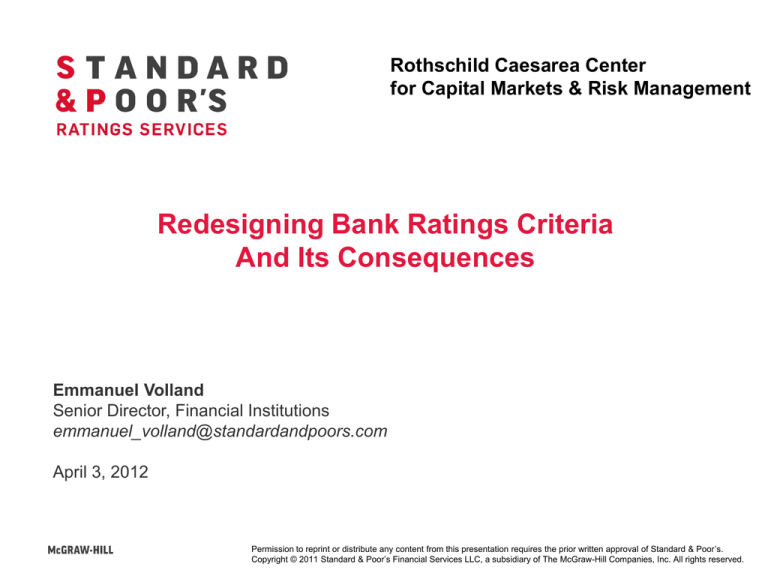
Rothschild Caesarea Center
for Capital Markets & Risk Management
Redesigning Bank Ratings Criteria
And Its Consequences
Emmanuel Volland
Senior Director, Financial Institutions
emmanuel_volland@standardandpoors.com
April 3, 2012
Permission to reprint or distribute any content from this presentation requires the prior written approval of Standard & Poor’s.
Copyright © 2011 Standard & Poor’s Financial Services LLC, a subsidiary of The McGraw-Hill Companies, Inc. All rights reserved.
Our Objective And What The Criteria Provide
Objective: To create an integrated, globally consistent framework, that:
• Builds on what we knew and have learned
• Recognizes the impact of industry and macro-economic factors
• Incorporates the incremental criteria changes we have made
• Utilizes the analytical tools we have developed
The revised criteria provide:
• An intuitive framework that guides fundamental analysis
• Greater clarity on the building blocks of S&P’s bank ratings
– BICRA, used to assess the industry and economic factors
– Analysis of bank specific business and financial risks
– Potential for extraordinary support (Government / Parental)
– Peer review
2.
Permission to reprint or distribute any content from this presentation requires the prior written approval of Standard & Poor’s.
3.
Permission to reprint or distribute any content from this presentation requires the prior written approval of Standard & Poor’s.
BICRA – Main Factors
Economic Risk
Industry Risk
A. Economic resilience
A. Institutional framework
• Economic Structure and stability
• Macroeconomic policy flexibility
• Political Risk
• Banking regulation and supervision
• Regulatory track record
• Governance and transparency
B. Economic imbalances
• Private-sector credit growth
• Residential real estate prices
• Equity prices
• Current-account balance and external debt position
B. Competitive dynamics
• Risk appetite
• Industry stability
• Market distortions
C. Credit risk in the economy
C. System-wide funding
• Private-sector debt capacity and leverage
• Lending and underwriting standards
• Payment culture and rule of law
• Sovereign government credit stress
• Core customer deposits
• External funding
• Domestic debt capital markets
• Government role
Source: Banking Industry Country Risk Assessment Methodology And Assumptions
4.
Permission to reprint or distribute any content from this presentation requires the prior written approval of Standard & Poor’s.
BICRA Outcomes
5.
Permission to reprint or distribute any content from this presentation requires the prior written approval of Standard & Poor’s.
The Anchor
Table 2 - Determining The Anchor SACP From Economic Risk And Industry Risk
Economic risk
1
2
3
4
5
6
7
8
9
10
1
a
a
a-
bbb+
bbb+
bbb
2
a
a-
a-
bbb+
bbb
bbb
bbb-
3
a-
a-
bbb+
bbb+
bbb
bbb-
bbb-
bb+
4
bbb+
bbb+
bbb+
bbb
bbb
bbb-
bb+
bb
bb
5
bbb+
bbb
bbb
bbb
bbb-
bbb-
bb+
bb
bb-
b+
6
bbb
bbb
bbb-
bbb-
bbb-
bb+
bb
bb
bb-
b+
bbb-
bbb-
bb+
bb+
bb
bb
bb-
b+
b+
bb+
bb
bb
bb
bb-
bb-
b+
b
bb
bb-
bb-
b+
b+
b+
b
b+
b+
b+
b
b
b-
Industry risk
7
8
9
10
Source: Banks: Rating Methodology And Assumptions
6.
Permission to reprint or distribute any content from this presentation requires the prior written approval of Standard & Poor’s.
7.
Permission to reprint or distribute any content from this presentation requires the prior written approval of Standard & Poor’s.
SACP – Bank Specific Factors (1)
Source: Banks: Rating Methodology And Assumptions
8.
Permission to reprint or distribute any content from this presentation requires the prior written approval of Standard & Poor’s.
SACP – Bank Specific Factors (2)
Source: Banks: Rating Methodology And Assumptions
9.
Permission to reprint or distribute any content from this presentation requires the prior written approval of Standard & Poor’s.
SACP Illustration
Bank Specific Factors
BICRA
SACP
a
abbb+
bbb
+1
No
change
bbb
-1
No
change
bbb
bbbbb+
10.
Anchor
Business
Position
Capital and
Earnings
Risk
Position
Funding
Liquidity
SACP
bbb
Strong
Adequate
Moderate
Average
Adequate
bbb
Permission to reprint or distribute any content from this presentation requires the prior written approval of Standard & Poor’s.
Peer Group Definition
SACP Factor
Comparative group
Business Position
Banks with similar Industry Risk
Capital and Earnings
All banks globally
Risk Position
Banks with similar Economic Risk and product mix
Funding & Liquidity
Funding: all banks in a country
Liquidity: all banks globally
Source: Table 4 of Banks: Rating Methodology And Assumptions
11.
Permission to reprint or distribute any content from this presentation requires the prior written approval of Standard & Poor’s.
Business Position Components
Table 5 - Business Position Subfactors And Indicators
Subfactors
Explanation
Indicators
Business
stability
The stability or fragility of a bank's
franchise
Revenue stability, market shares, and the
customer base
Concentration
or diversity
The concentration or diversification
of business activities
Contribution of different business lines and
geographies to overall revenue
Management
and corporate
strategy
The quality of management,
strategy, and corporate governance
Strategic positioning, operational
effectiveness, financial management, and
governance and financial policies
Source: Banks: Rating Methodology And Assumptions
12.
Permission to reprint or distribute any content from this presentation requires the prior written approval of Standard & Poor’s.
Business Position
Table 6 - Business Position Assessment
Qualifier
What it means
Very Strong
A bank’s business operations make it better placed to withstand adverse operating
conditions than the industry risk score indicates.
Strong
A bank’s business operations make it somewhat less vulnerable to adverse operating
conditions than the industry risk score indicated.
Adequate
A bank’s business operations are representative of the industry risk score.
Moderate
A bank’s business operations make it more vulnerable to adverse operating conditions
than the industry risk score indicates.
Weak*
A bank’s business operations make it significantly more vulnerable to operating conditions
than the industry risk score indicates.
Very Weak
The industry risk score is not representative of a bank’s vulnerability to adverse operating
conditions. (This category applies only in exceptional circumstances.)
*The impact on the SACP is a deduction of two or three notches. Three notches applies only in the fragmented
industries with a large number of smaller banks that all have weaker-than average industry risk. Deducting two or three
notches from the SACP for a weak classification helps to differentiate such banks further.
Source: Banks: Rating Methodology And Assumptions
13.
Permission to reprint or distribute any content from this presentation requires the prior written approval of Standard & Poor’s.
Capital & Earnings Components
Regulatory capital
Risk Adjusted Capital Ratio
Quality of capital & earnings
Earnings capacity
14.
Permission to reprint or distribute any content from this presentation requires the prior written approval of Standard & Poor’s.
RAC Ratio Is Our Key Measure of Capitalization
Borderline ratios are further informed by quality of capital and earnings
15.
Permission to reprint or distribute any content from this presentation requires the prior written approval of Standard & Poor’s.
Risk Position Components
Growth & changes in exposure
Risk concentration & risk
diversification
Complexity
Risks not covered by RACF
Loss experience and
expectations
16.
Permission to reprint or distribute any content from this presentation requires the prior written approval of Standard & Poor’s.
Funding
Table 15 – Funding Assessment
Descriptor
What it means
Above Average
A bank exhibits stronger funding metrics than the average for all banks in
the same country.
Average
A bank exhibits similar funding metrics than the average for all banks in
the same country.
Below Average
A bank exhibits weaker funding metrics than the average for all banks in
the same country.
Source: Banks: Rating Methodology And Assumptions
17.
Permission to reprint or distribute any content from this presentation requires the prior written approval of Standard & Poor’s.
Liquidity
Table 16 – Liquidity Assessment: Strong Adequate, Moderate, Weak, Very Weak
Qualifier
What it means
Strong
The bank is able and prepared to successfully manage its liquidity, and can survive
under stressful conditions for 12 months without significant – generally less than
10% - dependence on central bank funding.
Adequate
The bank is able and prepared to successfully manage its liquidity, and can likely
survive under stressful conditions for more than six months, but with a possibility
that dependence on central bank funding can become significant – generally less
than 25% - after the first six months.
Moderate
The bank is less able and prepared to manage its liquidity. It is less likely that the
bank can survive under adverse conditions for more than six months without heavy
dependence – up to 25%-50% - on the central bank.
Weak
The bank is unable or unprepared to manage without extraordinary central bank
support, which is greater than 50% and is likely to be available for as long as
needed to correct imbalances.
Very Weak
The bank is unable or unprepared to manage its liquidity in adverse economic and
market conditions without extraordinary central bank support, which is available and
more than 50% but may be finite.
Source: Banks: Rating Methodology And Assumptions
18.
Permission to reprint or distribute any content from this presentation requires the prior written approval of Standard & Poor’s.
19.
Permission to reprint or distribute any content from this presentation requires the prior written approval of Standard & Poor’s.
Factoring Extraordinary Support Into The SACP
Source: Banks: Rating Methodology And Assumptions
20.
Permission to reprint or distribute any content from this presentation requires the prior written approval of Standard & Poor’s.
Determining Systemic Importance
Table 18: Systemic Importance
Descriptor
Observations
High systemic
importance
A loss of confidence in a bank is likely to lead to a loss of confidence in the entire
national banking system. In particular, a default of a bank’s senior unsecured
obligations is likely to weaken the country's financial system, limit the availability of
credit for the private sector and trigger a significant financial stress at several other
financial institutions.
Moderate
systemic
importance
A loss of confidence in a bank may lead to a loss of confidence in the entire
banking system. In particular, a default on a bank’s senior unsecured obligations
can weaken the financial system and limit the supply of credit for the private sector.
Low systemic
importance
A bank has low systemic importance when it does not fit the criteria for high or
moderate systemic importance. The majority of banks in a banking industry are
likely to be in this category. However, if the market is particularly concentrated,
fewer banks are likely to have low systemic importance.
Source: Banks: Rating Methodology And Assumptions
21.
Permission to reprint or distribute any content from this presentation requires the prior written approval of Standard & Poor’s.
Governments Tendency to Bail Out
Source: Banks: Rating Methodology And Assumptions
22.
Permission to reprint or distribute any content from this presentation requires the prior written approval of Standard & Poor’s.
Likelihood Of Extraordinary Government Support In The Future
Table 20: Likelihood Of Extraordinary Government Support In The Future
Government’s tendency to support
private-sector commercial banks
Systemic importance
Highly
supportive
Supportive
High
High (table 21)
Moderately high
(table 22)
Low
Moderate
Moderately high (table
22)
Moderate (table 23)
Low
Low
Low
Low
Low
Source: Banks: Rating Methodology And Assumptions
23.
Uncertain
Permission to reprint or distribute any content from this presentation requires the prior written approval of Standard & Poor’s.
Moderately High Likelihood of Extraordinary Government Support
Source: Banks: Rating Methodology And Assumptions
24.
Permission to reprint or distribute any content from this presentation requires the prior written approval of Standard & Poor’s.
Group Rating Methodology
Table 1
Summary Table Of Associating An Entity's Group Status With An Indicative Long-Term Rating
Group status
Brief definition
Indicative longterm rating
Core
Integral to the group's current identity and future strategy. The rest
of the group is likely to support these entities under any
foreseeable circumstances.
Generally at
GCP
Highly
strategic
Almost integral to the group's current identity and future strategy.
The rest of the group is likely to support these subsidiaries under
almost all foreseeable circumstances.
Generally one
notch below
GCP
Strategically
important
Less integral to the group than highly strategic subsidiaries. The
rest of the group is likely to provide additional liquidity, capital, or
risk transfer in most foreseeable circumstances. However, some
factors raise doubts about the extent of group support.
Generally three
notches above
SACP
Moderately
strategic
Not important enough to warrant additional liquidity, capital, or risk
transfer support from the rest of the group in some foreseeable
circumstances. Nevertheless, there is potential for some minimal
support from the group.
Generally one
notch above
SACP
Nonstrategic
No strategic importance to the group. These subsidiaries could be
sold in the near to medium term.
Generally at
SACP
*ICR—Issuer credit rating. It is subject to sovereign rating constraints and application of government support criteria. GCP—Group credit profile. SACP—
Stand-alone credit profile.
Source: Standard & Poor's.
25.
Permission to reprint or distribute any content from this presentation requires the prior written approval of Standard & Poor’s.
Overview Of Important Criteria Publications
• Credit Stability Criteria, May 3, 2010
• Stand-Alone Credit Profiles: One Component Of A Rating, Oct. 1, 2010
• Bank Capital Methodology And Assumptions, Dec. 6, 2010
• Rating Government-Related Entities: Methodology And Assumptions, Dec. 9, 2010
• Bank Hybrid Capital Methodology And Assumptions, Nov. 1, 2011
• Banks: Rating Methodology And Assumptions, Nov. 9, 2011
• Banking Industry Country Risk Assessment Methodology And Assumptions, Nov. 9, 2011
• Group Rating Methodology And Assumptions, Nov. 9, 2011
• Table Of Contents: Standard & Poor's Financial Institutions Ratings Criteria, Nov. 11, 2011
26.
Permission to reprint or distribute any content from this presentation requires the prior written approval of Standard & Poor’s.
www.standardandpoors.com
Copyright © 2011 by Standard & Poor’s Financial Services LLC (S&P), a subsidiary of The McGraw-Hill Companies, Inc. All rights reserved.
No content (including ratings, credit-related analyses and data, model, software or other application or output therefrom) or any part thereof (Content) may be modified, reverse engineered, reproduced or
distributed in any form by any means, or stored in a database or retrieval system, without the prior written permission of S&P. The Content shall not be used for any unlawful or unauthorized purposes. S&P, its
affiliates, and any third-party providers, as well as their directors, officers, shareholders, employees or agents (collectively S&P Parties) do not guarantee the accuracy, completeness, timeliness or availability
of the Content. S&P Parties are not responsible for any errors or omissions, regardless of the cause, for the results obtained from the use of the Content, or for the security or maintenance of any data input by
the user. The Content is provided on an “as is” basis. S&P PARTIES DISCLAIM ANY AND ALL EXPRESS OR IMPLIED WARRANTIES, INCLUDING, BUT NOT LIMITED TO, ANY WARRANTIES OF
MERCHANTABILITY OR FITNESS FOR A PARTICULAR PURPOSE OR USE, FREEDOM FROM BUGS, SOFTWARE ERRORS OR DEFECTS, THAT THE CONTENT’S FUNCTIONING WILL BE
UNINTERRUPTED OR THAT THE CONTENT WILL OPERATE WITH ANY SOFTWARE OR HARDWARE CONFIGURATION. In no event shall S&P Parties be liable to any party for any direct, indirect,
incidental, exemplary, compensatory, punitive, special or consequential damages, costs, expenses, legal fees, or losses (including, without limitation, lost income or lost profits and opportunity costs) in
connection with any use of the Content even if advised of the possibility of such damages.
Credit-related analyses, including ratings, and statements in the Content are statements of opinion as of the date they are expressed and not statements of fact or recommendations to purchase, hold, or sell
any securities or to make any investment decisions. S&P assumes no obligation to update the Content following publication in any form or format. The Content should not be relied on and is not a substitute for
the skill, judgment and experience of the user, its management, employees, advisors and/or clients when making investment and other business decisions. S&P’s opinions and analyses do not address the
suitability of any security. S&P does not act as a fiduciary or an investment advisor. While S&P has obtained information from sources it believes to be reliable, S&P does not perform an audit and undertakes
no duty of due diligence or independent verification of any information it receives.
S&P keeps certain activities of its business units separate from each other in order to preserve the independence and objectivity of their respective activities. As a result, certain business units of S&P may
have information that is not available to other S&P business units. S&P has established policies and procedures to maintain the confidentiality of certain non–public information received in connection with
each analytical process.
S&P may receive compensation for its ratings and certain credit-related analyses, normally from issuers or underwriters of securities or from obligors. S&P reserves the right to disseminate its opinions and
analyses. S&P's public ratings and analyses are made available on its Web sites, www.standardandpoors.com (free of charge), and www.ratingsdirect.com and www.globalcreditportal.com (subscription), and
may be distributed through other means, including via S&P publications and third-party redistributors. Additional information about our ratings fees is available at www.standardandpoors.com/usratingsfees.
Permission to reprint or distribute any content from this presentation requires the prior written approval of Standard & Poor’s.
27.
STANDARD & POOR’S, S&P, GLOBAL CREDIT PORTAL and RATINGSDIRECT are registered trademarks of Standard & Poor’s Financial Services LLC.


